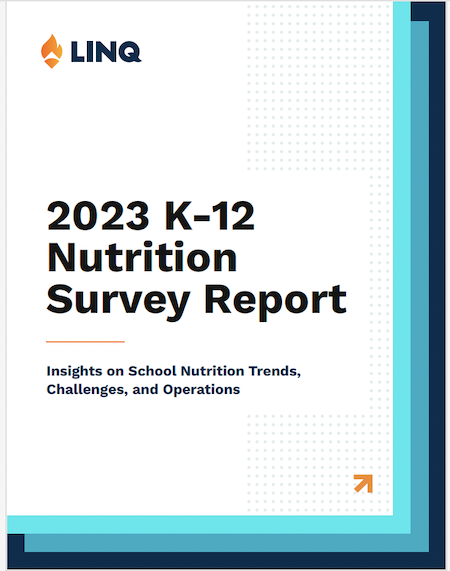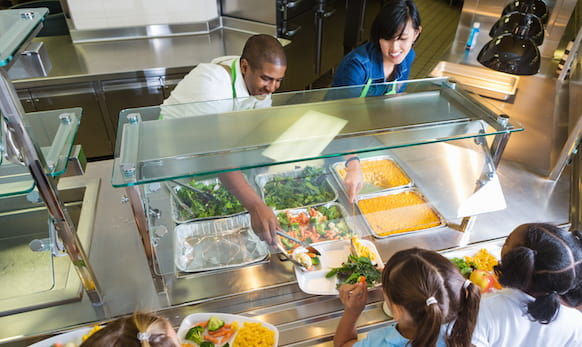Keep Kids Fed Act funding ended this year, which means a return to pre-pandemic meal reimbursement rates for most schools and districts. National School Lunch Program (NSLP) reimbursement rates for the ’23-’24 school year confirmed this. The news came shortly before the 2023 School Nutrition Association’s (SNA) Annual National Convention (ANC) last July, so it was a hot conversation topic on the conference floor.
Many K-12 nutrition professionals we met in our booth at the 2023 SNA ANC shared concerns about what the updated reimbursement rates mean for their nutrition programs. These worries aren’t new, and fears of insufficient reimbursement rates will only compound the problem. Our 2023 K-12 Nutrition Survey Report reveals that nearly 60% of Food Service Directors are extremely or somewhat concerned about per-meal reimbursement rates not covering the cost of a producing reimbursable meal. Plus, only 56% of respondents feel they do well at collecting meal applications. On top of that, 78% of respondents agree that nutrition/food service budgets will only get tighter in the future.
However, the news isn’t all bleak. Additional funding is streaming in to help address reimbursement shortfalls. CPI data shows a 296% school food price increase from April 2022 to April 2023, so the USDA sees a clear need for financial support. They stepped in with a third round of Supply Chain Assistance Funding for Schools totaling nearly $1.3 billion—that adds up to nearly $3.8 billion since December 2021. Districts participating in the NSLP can use these funds to purchase unprocessed or minimally processed domestic food products.
The additional funding will help, but there are still ways schools can maximize their eligible reimbursement. They can also create a little more financial cushion by identifying opportunities to increase revenues in their nonprofit food service account. This could include snack and à la carte sales or beginning a catering program.
Maximize meal reimbursement rates
For schools and districts not participating in the Community Eligibility Provision (CEP) or other programs such as Provision 2, it’s imperative to maximize their free and reduced numbers to receive those higher reimbursement rates. These numbers can be increased through two different ways:
Direct certification
Direct certification is one of the most important ways to certify children for free meals. Children are automatically eligible if they receive Supplemental Nutrition Assistance Program (SNAP), Temporary Assistance for Needy Families (TANF), or Medicaid (in certain states) benefits. Eligibility through direct certification can be extended to other children in the household.
Tips for direct certification success:
- Conduct direct certification regularly to capture all those eligible
- Make efforts to extend that eligibility to the rest of the household
- Look closely for new students and close spelling matches to those already certified
Spending time to closely review the direct certification lists to capture and identify all students and extend eligibility as appropriate helps boost reimbursements. It also helps with CEP eligibility when it comes time to evaluate at the end of the school year.
Meal applications
Families must submit a meal application if a child cannot be directly certified for free or reduced meals. The importance of improving your district’s ability to collect meal applications cannot be understated. Collecting meal applications may be time-consuming, but the more time you can devote and develop strategies to increase submissions, the better.
Tips for meal application collection success:
- Make meal applications available in multiple languages
- Provide online meal applications and assistance if necessary
- Set up stations during school events, like back to school, to quickly collect applications
Partner with the school nurses, school counselors, and other support staff to encourage families to submit applications any time throughout the year. A change in the family can make a student eligible free or reduced meals even if they weren’t at the beginning of the school year.
Get insights and tips for maximizing K-12 nutrition program funding
Increasing free and reduced numbers helps K-12 nutrition program tap into more potential revenue. It also helps ensure that every child eligible for a free meal receives one. This keeps bellies full and can even contribute to lower meal debt.
In addition to maximizing your reimbursement, there are other ways to generate revenue for your nutrition program. Boosting your a la carte sales, simplifying meal payments, starting a catering program, and providing vending meals to other nutrition programs are all tactics that can help increase revenue as your district is concerned with the rising costs of school meals.
For more information about the challenges schools are facing in their nutrition programs, read our full K-12 nutrition report.

